

It is the 50th anniversary of the first Earth Day celebration and we have loads of STEM ideas for you and your family to try! Our Earth Day celebration ideas will be shared in a 2-part blog post. In this blog post, we are sharing the Sustainability and the Environment playlist, consisting of 4 short videos, from the talkSTEM YouTube channel together with 5 activities for you to try at home.
Sustainability and the Environment
The Sustainability and the Environment playlist on the talkSTEM YouTube Channel was created as part of our effort to curate walkSTEM experiences by educational content or topic, instead of by location. This effort was initiated in response to a number of requests by parents and teachers who are part of the talkSTEM community. This varied playlist highlights architecture that was designed explicitly to help with sustainability goals, and includes how you can estimate and explore environmental components, such as a large body of water, or how grass grows.
We hope you will use this playlist to spark your curiosity, and to better understand the growing, overlapping connections between science, technology, engineering, math, art and architecture. We know that the success of our planet depends on today’s youth making connections between the environment and other disciplines to solve sustainability problems. We want to share the message that you can explore and look after our planet any where you are! Also that the knowledge and skills it takes to be an environmental scientist, engineer, or any other career path that relates to our planet’s well-being can be developed continuously.
In this playlist, you can explore:
Can Math Help Grass Grow?
Dr. Glen Whitney explores the geometry and structure of tall grass planted outside a building in downtown Dallas, Texas. You will learn why the grass grows in the angles that it does, and how that could potentially translate into optimizing the growth of crops in agriculture.
How Does Environment Affect the Design of a Building?
The video takes place at the Dallas Holocaust and Human Rights Museum in Texas. The building was recently remodeled, and now displays a unique metal sheeting on the outside. The video explores why the building appears this way, how the Texas environment will eventually change the building, and why the architect planned for this.
You can try this demonstration of a natural reaction on your own! All you need are 2 pennies, one that is newer and one that is older.
How Much Water Is Saved?
This video takes place at the Girl Scouts STEM Center of Excellence at Camp Whispering Cedars in Dallas, Texas. The video provides an example of how one can estimate the volume of water saved by the rain barrels. How do you think this calculation could be important for sustainability work?
Do you use rain barrels? You can take this opportunity to calculate how much water YOU can save by using one rain barrel.
You can create an activity from this video by creating a poster chart to track how much water your household uses. You can decide how often you revisit or update your chart. What goals can you set together to save water?
Art Deco and the Environment
This video highlights artwork found outdoors at Fair Park in Dallas, TX. The video invites you to explore the vast connections between art, art preservation, invisible forces, and the sustainability of the Earth. Can you think of other invisible forces that may be affecting the outdoor artwork at Fair Park? What about rain or wind? Similarly to how sunlight can affect the murals outside, humans also have invisible forces that effect the Earth. Can you list some of these invisible forces? How might that effect our environment and the planet
The exciting fact is that science, technology, engineering, art and math (STEAM) elements can be found in any outdoor element. These experiences outside can contribute to a child’s ability to adopt a STEM mindset and can affect the child’s future relationship with the STEM field. As a caretaker, parent or teacher, you do NOT need a STEM background, or a good relationship with math, to engage in these activities with your child.
We’d also like to share 5 activities with you that are all about having fun exploring together, regardless of the environment you visit. Each activity has a time range below the title to give you an idea of the low end, minimal time required, and the higher end, extension of activity.
Earth Day Activities
1. Nature Scavenger Hunt
30 minutes – daily activity multiple times a week/month
Go on a Nature Scavenger Hunt. This document can be downloaded and printed for as many players as you like. The scavenger hunt challenges you to find and experience each item on the list. You can create a game from this scavenger hunt by creating teams of children that must work together to complete the list. The goal is for children to become aware of the outdoors and their surroundings. Your child can create, build, listen, estimate, measure, and more using this scavenger hunt.
Download the Nature Scavenger Hunt HERE.
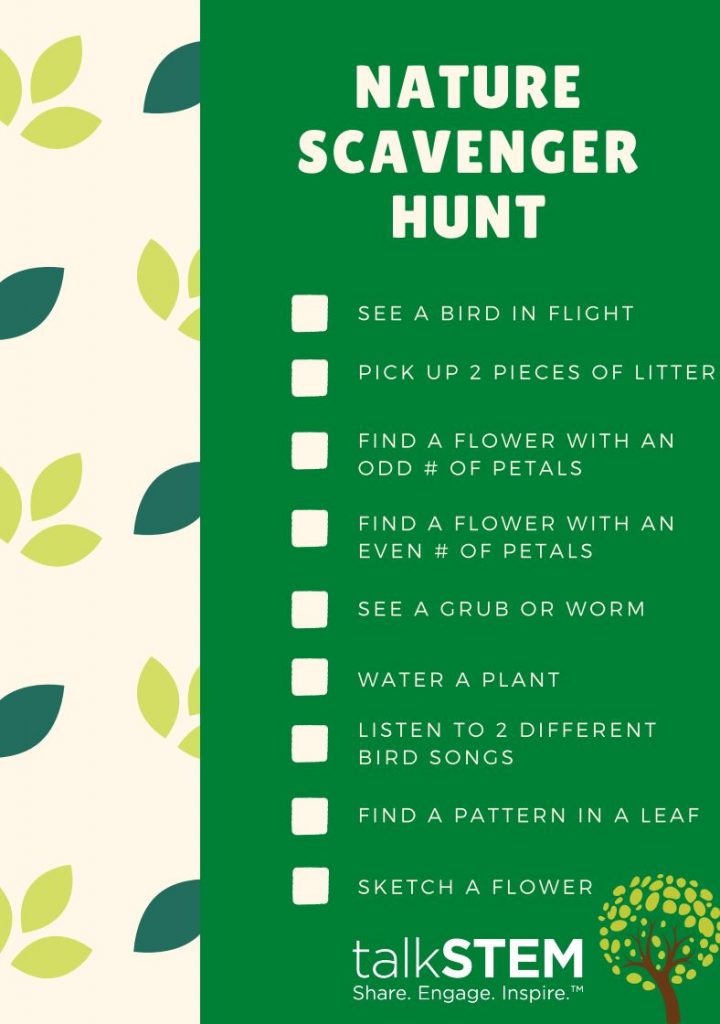

2. Nature BINGO
20 minutes – play multiple times a week/month
Play Nature Bingo. You can print off the following BINGO chart and see how many squares you can mark off in one afternoon. You may be surprised by how much you explore and learn in a short time!
Download Nature BINGO HERE.
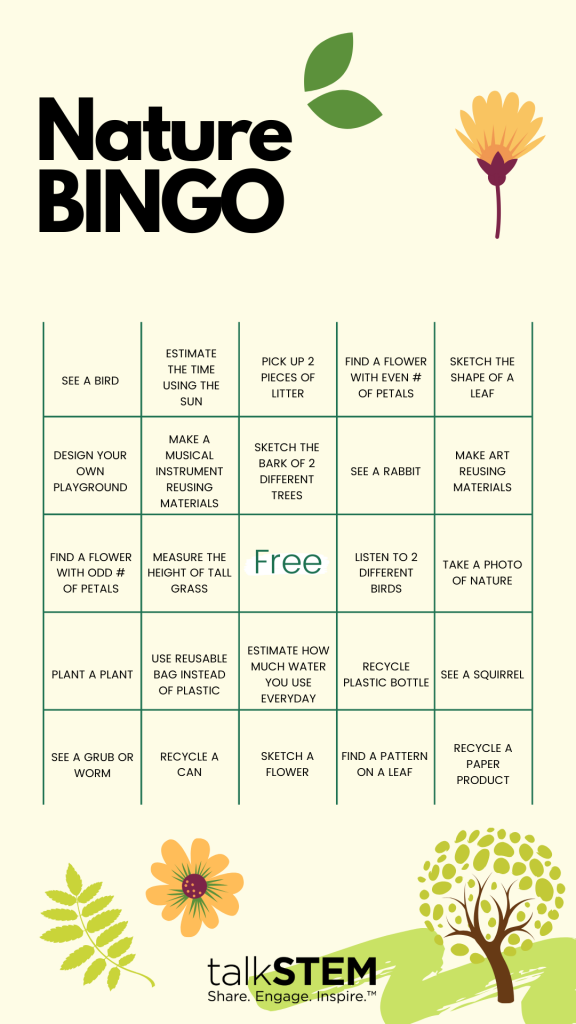

3. Reduce, Reuse, Recycle Goals
10 minutes – revisit and update as often as you like
With your family, you can create and decorate a poster together with different goals like: recycling more, wasting less food, wasting less water, using reusable bags instead of plastic, etc.
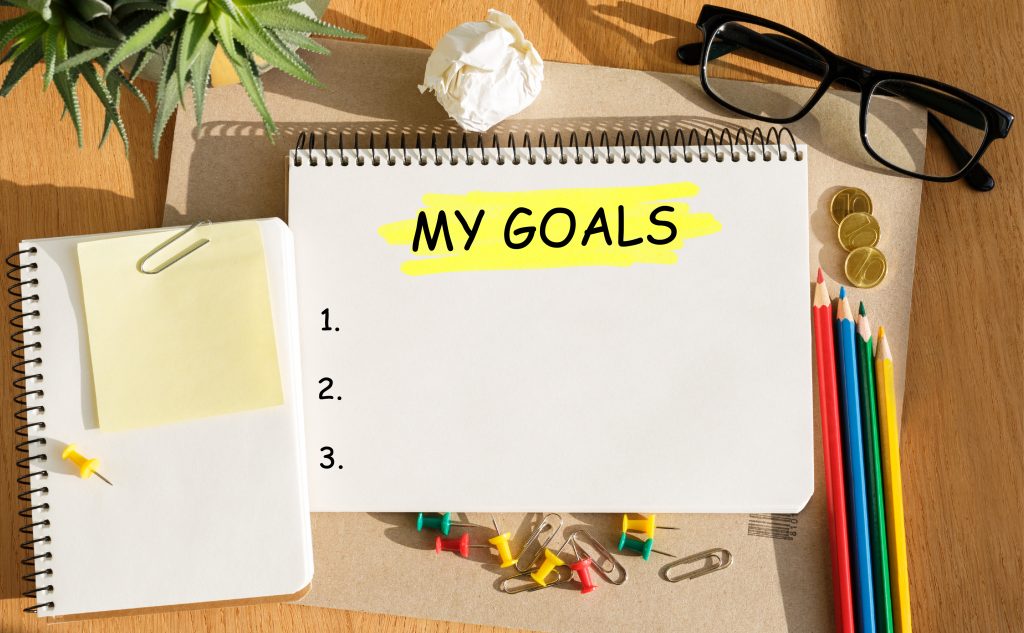

4. Reusable Artwork Inspired by Nature
30 minute craft – multiple art sessions in a week/month
A fun way to learn how to reuse is to create a piece of art or a musical instrument with used materials. Cardboard boxes, plastic bottles, aluminum cans, bottle caps, plastic bags, paper rolls, etc. all make great materials for crafting your own artwork. Look online to get inspiration from many artists who reuse materials. Share your work with us, we’d love to see what you create!
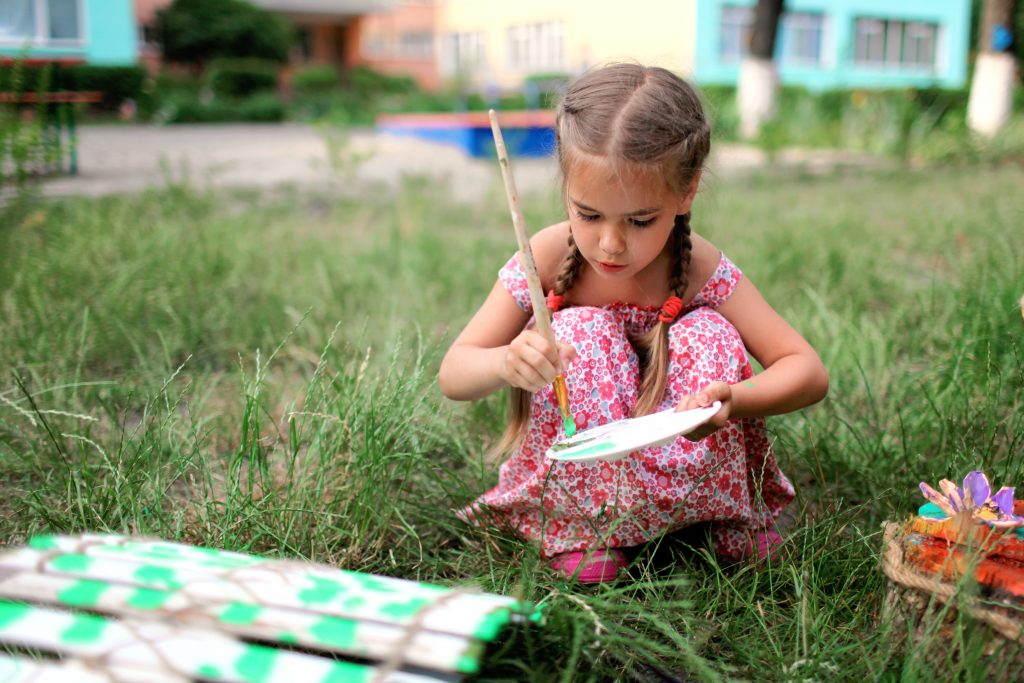

5. Artwork Inspired by Nature
30 minute craft – multiple art sessions in a week/month
The next time you view a piece of art, see if you can identify elements of nature in them. You can print different pieces or create a PPT slideshow and see how many natural elements you can find. Create some friendly competition and see who can list the most nature-inspired elements! Great for an online class or family fun.
Artwork can often showcase patterns, colors, and symbols we often identify with nature. For a fun craft activity, use any medium to create a piece of artwork inspired by nature. For young artists, you can create a still life with things found in your backyard. Setting and designing the still life is half the fun, let the child make creative decisions about what objects they will include.


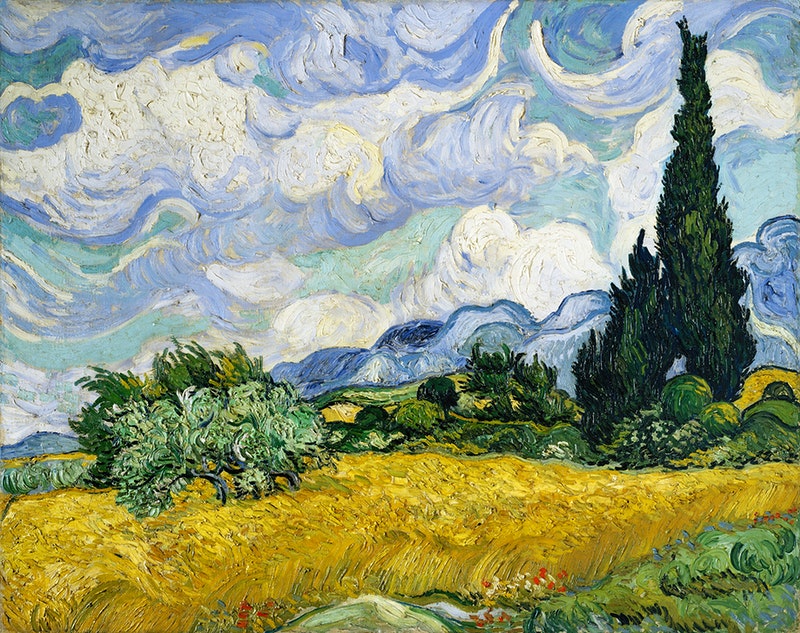

We hope that you find these various Earth Day activities helpful and fun, not contributing to your stress. We would love to see photos and videos of your family celebrating Earth Day how you choose. You can read Part 2 of the blog here.
Share your experiences with us:
Facebook: @talkstem Instagram: @talkingstem Twitter: @talkingstem








Add comment